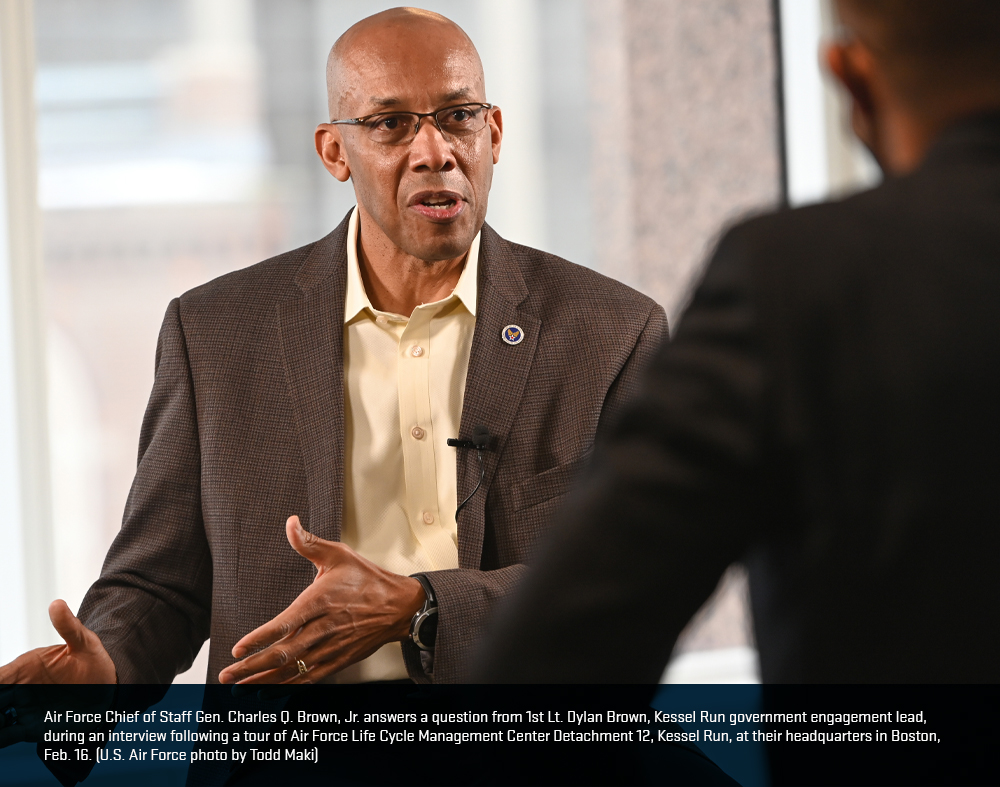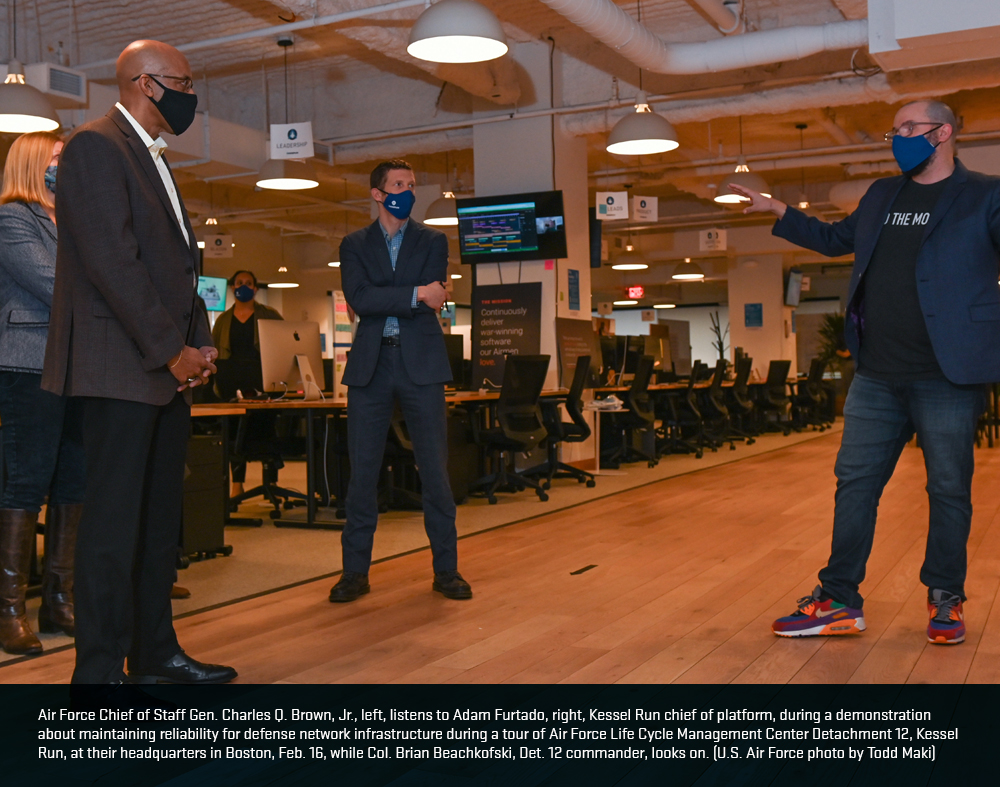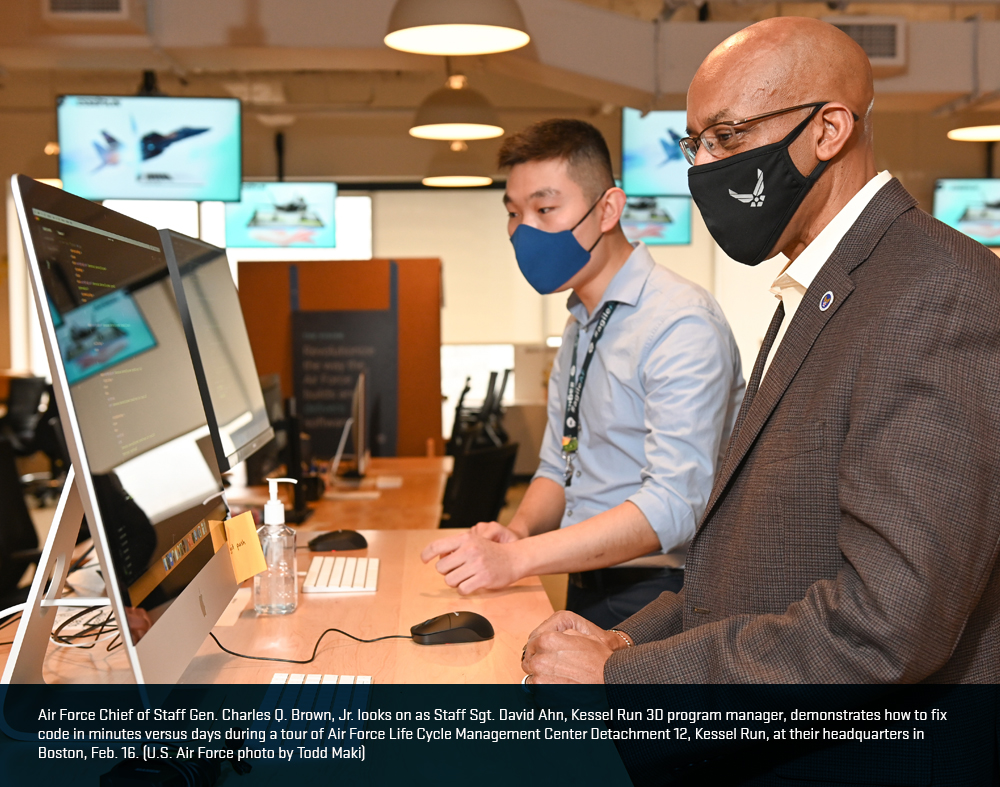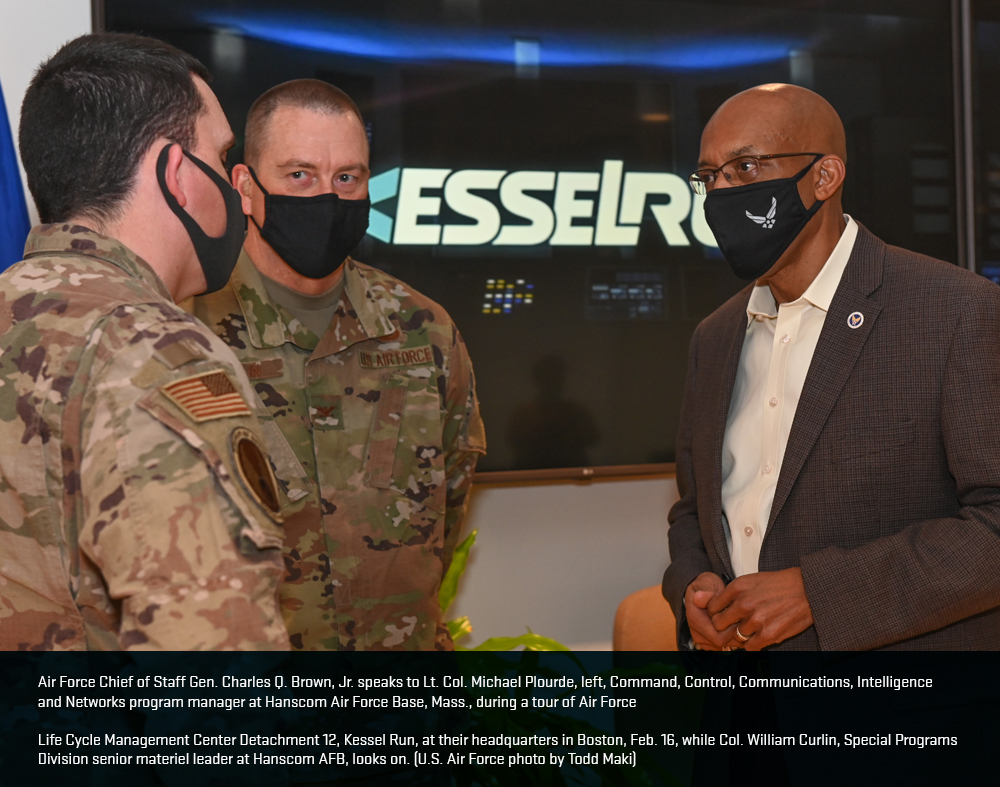Exclusive Interview with General Charles Q. Brown Jr.
Chief of Staff, United States Air ForceFebruary 18, 2021, by Peter Ising (Kessel Run Marketing and Publicity Director)

Kessel Run: So, we've been told that you're not often interviewed out of uniform. How does it feel to be outside of uniform?
General C.Q. Brown: Actually, it's good to get dressed up every once in a while. As I was telling a couple of folks on the trip, that I've been reading GQ since I was in high school and I dressed myself. So, to be able to pull something out of my closet versus uniform, it's a, it's a good day.
Kessel Run: We (Kessel Run) started as a pathfinder organization and since we broke the ice, we have seen a wave of software development, innovation efforts pop up across the DoD. How has the DoD and United States Air Force shifted the way it looks at acquiring software? And what role does software have in the future of the Air Force?
General C.Q. Brown: I'll tell you; I think software has always played a role in the Air Force, but we were often dependent on others to do the software for us, and we ended up having to pay to move forward. I think what I've seen here with Kessel Run, and not only Kessel Run, but other locations I've been that are similar to Kessel Run, where Kessel Run has been in the lead is the excitement our Airmen have, and the Air Force has about software. And I think we see it in our day-to-day lives of what software can do for us. We want to incorporate that into what we do inside of the United States Air Force. And so, there's a lot of value in the things we're able to do, and that's been impressive, what I've seen across the Air Force. I've heard a lot about Kessel Run. This is my first opportunity to come to visit. I've been very, very impressed.
Kessel Run: Industry is putting a high value on software development. For example, the banking industry now has more software developers than it does bank tellers. Do you see the Air Force growing in its software development capabilities, and why?
General C.Q. Brown: Well, I do. There's an aspect of us understanding not only the development of the software, but it's how we engage with our operators and that dialogue that goes back and forth as we develop the software. I'll just say from my own experience, typically the software was done or the platform was built, has gone through testing and it gets out to me as an operator. And by the time I get it, there's probably something else I've already thought about that I'd like to get achieved. And that's the beauty of the way we approach software today, and what I saw today, is we're able to do that very quickly. And so, you can in stride and make changes as you go to make it better for our operators. And that to me is where software comes into play. I think the technology is out there. Sometimes there's a policy. And as I said, there's a difference between can't do and don't want to do. Physically, we can do it based on technology, sometimes it's a will problem. We've got to get past some of the will problem and policy issues to allow us to further take advantage of software. At the same time, we protect the data as part of our national security.
Kessel Run: That's in line with your “Accelerate Change or Lose” concept. And then according to industry best practices, the software is never done. And you touched on this a little bit already. This works in the private sector because venture capital can fund a startup, and then its commercial viability, user adoption, and market capitalization begins to cover the costs until the revenue profit. In the DoD, it's as if that MAJCOM level, it becomes that venture capital role. But because there's no ability for the users really to be paying for it, you end up being attached to that venture capital model in perpetuity. How do we begin to overcome this bottom line where, in these cases, costs might increase if you look at the bottom line from a scale standpoint? How do we begin to overcome the information and expectation problem at the MAJCOM level as these costs seem to be getting bigger because adoption is growing?
General C.Q. Brown: One of the conversations we had today was education. The more we collectively, at the major command level, my level included, with the major command commanders, with their staffs, of how this can work., and I don't know that we're quite there yet, and this is where you see Kessel Run and other entities that work very closely with the commercial sector, can see what's in the realm of the possible. And the thing we got to think through is how do we get past from where we were 5, 10, 15 years ago and move to this new area?
The way we do that is education and helping all of our staff understand that. And I don't know that we're quite there yet, which is why you have what I would call pockets of resistance that slow us down, because they don't understand it. And because it's new, they want to stay in their comfort zone versus where we need to go. That's exactly what accelerate change is. Because we cannot continue to do things the same way and expect a different result. If we do, we're on something and we've got to get past that. To me personally, we've got to really break down some of these barriers, educate, and then those that don't get it, we need to move out of the way so we can move forward.
Kessel Run: Now, the forces are preparing for a war with a near-peer adversary. What does that war look like? And how has digital transformation changed that picture from the conflicts we have been in until now? What do we stand to lose?

General C.Q. Brown: Let me start with going to the National Defense Strategy. We want to compete below the level of armed conflict. So, the goal is not to get to war. Okay? And if we can accelerate fast enough in certain areas with software, then I want to keep it so that our adversaries are continually guessing and we're able to deter them. If they get to a level of confidence where they think they can do something, then that would get us to a path of war. What we're looking to do is how do we do things today to prepare us all the way to keep us in competition? But if we go to conflict, if we go to war, I want to make sure we're ready. I'm balancing two sides of the scale there. I want to confuse our adversary, go faster than they can. At the same time, when the clock stops and says, "It's time," we are far enough ahead that we're in a good position from a war-fighting perspective to win.
Kessel Run: Now, you recently visited the CAOC, what do you think the future Air Operations Center needs to look like for us to be prepared for the next near-peer conflict?
General C.Q. Brown: Well, I've spent quite a bit of time at the CAOC. I was there as a deputy commander; I was there as the commander. I was one of the ones that asked for the tanker planning tool to get from a whiteboard to a tool we can use. It's using the application. That's what I saw today, the various applications for the various mission threads that will make life easier for those who are executing the mission. And what I also saw in the demo today is how we can do that from a distributed ops perspective.
So, you don't have to have everybody sitting in at the same location. You're able to move data. It's really about the data, and how we move that data. We have all the data, it's on a PowerPoint slide or Excel spreadsheet someplace, on a share drive, we just don't know where it is. We've got to get past that. And I think that's where I see future AOCs.
It's about the data. It's how we move the data back and forth with the applications. And you only have to have the data at one time. You don't have to load it multiple times. And that's what I saw today. The fact that you can put it in one location and very quickly move the data around to allow everybody to do the things they need to do to support building a tasking order.
Kessel Run: Where do programs like ABMS and JADC2 fit into your vision for the Air Force?
General C.Q. Brown: I'm focused on ABMS, because ABMS is the software that's going to allow us to do decision-making and do Kill Chain. And it feeds into JADC2, because JADC2 is more the concept and how we work with our joint partners, with the Air Force on ABMS, the Navy on project Overmatch, the Army on Project Convergence, and the Marine Corps doing its work as well. We're all going with the same approach. I've talked to the other service chiefs.
What I've talked to them about is we've got to make sure we're talking about the same types of things, so we're going at the same pace. And so, the value of ABMS is really how do we look at data, how we look at digital infrastructure, sensor integration, all those things that allow us to move information faster, to allow decision-makers to make key decisions or to close the kill chain. And all those need to come together sooner than later. And we're not going to be able to solve it all at once, okay?

We're not going to be able to boil the ocean across the spectrum, but we've got to be able to deliver a capability each fiscal year. And that's what I'm focused on right now, each fiscal year we've got to get better, deliver a capability that we put in the hands of the war fighter so they have the tools they need today, not only today but into the future.
And as you mentioned earlier, it is never going to be done. We'll just continue to upgrade it with additional lines of code. And that's the beauty of places like Kessel Run.
Kessel Run: Now this next question, it's funny because sometimes we talk about “just sprinkle some A.I. on it and it makes everything better,” but how will artificial intelligence as a capability impact the Air Force's ability to accelerate change?
General C.Q. Brown: It'll speed up the decision-making process. I think we've all heard this well before we got to the point where we are today on software and coding, garbage in, garbage out. This is why we've got to have the right data. And this is part of where we, across the Air Force, have got to be willing to share our data. I had a conversation with parts of the staff last week, understanding how to share data. So, if I have data, what do I do to share it? How do I share that data? Once I share that data, then the AI tools can be built with the algorithms, and it can start to learn and it can speed up the decision-making process.
The one area I want to make sure we pay attention to is AI is not going to give us the final answer, but it'll speed up the process to give us the most likely answers. And then a human on the loop can then determine what is the best option using their judgment. That's where AI is going to speed up the process, because the human brain can only absorb so much data and process it. And I think that's where AI is going to be a real benefit for us.
Kessel Run: It's like having an Iron Man suit for decision-making.
General C.Q. Brown: Exactly, exactly. Although I'm a Spider-Man fan, just for the record.
Kessel Run: How do the action orders you published address the problems raised in the book, the Kill Chain? Are you familiar with the book?
General C.Q. Brown: I am. I've listened to it. I've read it, I've met the author and I know the author, Chris Brose. When I go through all four actual orders, they all build up on each other.
Action order A, on Airmen, it's how we develop Airmen, and how we empower Airmen, and how we empower Airmen like the Airman I saw today and the things they're able to do.
B is the bureaucracy. It's to cut through not just at the headquarters level, but across the aspects of how we deliver capability faster and make those decisions faster, in internal, the air force.
C is competition. It's understanding our adversary, and we've got to be able to go faster than our adversity. If we don't understand what they're doing, you don't know if you're going faster than they are. It's understanding how they think, what makes them tick.
And most importantly, one of the areas that Kessel Run and others were helping us out with is the design implementation. What does our Air Force need to look like in 2030, 2040, and beyond? And what we do today, and the processes we have today will not be successful in the future. I can almost guarantee you that.

We've got to think about that process. And I wrote the action orders, the areas first to focus on when I talk about “accelerate change.” And just like software development, all four of those are never-ending processes. And ideally, it's things we've all worked on before, but we've got to put pressure on ourselves and hold ourselves accountable to deliver the capability our Airmen need, but also the national security, our nation requires of the United States Air Force and our joint team.
Kessel Run: So it's 2030, “Accelerate Change or Lose,” has caused a wave of momentum. How has digital transformation and artificial intelligence changed the way we prevent, manage or win conflict? And how does that impact down to the individual Airmen?
General C.Q. Brown: I think it's flipped the script on how we do business. It's going to flip how we are able to look at the digital architecture, open mission system, and agile software. And the way I think about it is it'll be less about the actual platform or airplane. It's really how much computing power does it have and how quickly can I get code to it? Because I can see things happening, I can predict what's happening using AI and then be able to adjust the software so that we're staying one step ahead of our adversary.
Versus taking a year or two to put it back in development, put it back into testing, and then finally deliver it late to need. From that aspect, we've got to be able to move faster. We've also got to be willing to take a little bit of risk. And that is an area that is a little tougher for those of us in uniform. We take risk, but it's a different aspect of risk when we're talking about building future capability. And what I want to do is when we get to 2030 with the digital approach, we're in a much better place than we are today.
Kessel Run: What is the biggest Air Force shortfall that is hindering our Airmen?
General C.Q. Brown: I would say a bit of empowerment. It's how we empower Airmen. It's the trust that goes throughout the levels of leadership and command. And what I look at is I want our Airmen to be in a position they feel empowered and trust in their abilities to do what we've trained them to do, and then some. And they can do that without fear of getting in trouble for violating an Air Force instruction. At the same time, those at the more senior level need to trust their Airmen to be able to do their job.
And what I focus on is I do not like giving guidance. I want to give intent and authority. This is what I did during COVID in my last job. I told him command, "Do not call me asking for guidance, because I can give you guidance, but you're not going to like it. Because you're going to come back to me and go, 'Well, you're tying my hands.' I'm going to give you intent and authority. You go figure out how to do this." I think we need to do more of that with our Airmen. Give them the intent and the authority, the left and right limits. But it's a constant dialogue that goes back and forth on what they're doing, so you can help steer, guide and manage the risk.
Kessel Run: Very much still in line with one of our core values of ideas over rank, psychological safety, and having that open dialogue. Can you give an example of a time that you failed, and what the environment around you did to make sure that you learned and grew, and maybe some lessons learned from that what were things that you wish that environment did better to allow you to potentially learn or grow more?
General C.Q. Brown: I'd probably go back to when I was a First Lieutenant, showing up at Kunsan Air Force Base in Korea, my first operational assignment. And I was taking my first check ride as a fighter pilot in my first operational squadron and I failed. And then when I took the recheck, I got additional training because I didn't do as well on the recheck. So, I squeaked through. That was a motivator to me. Because I've always been very competitive, but it was a way that highlighted to me the things I needed to do.
At the same time, the attitude I had, because I had a positive attitude about it, is the help I got from those in my squadron. Matter of fact, the gentleman who gave me my check ride eventually hired me as one of his weapons officers when he became a squadron commander. It's those kinds of things that we're all going to have what I call a failure, an "Aw, shucks," moment. It's your attitude and how you bounce back from it. And that is where you endear their help.
If you complain about it, you're down in the dumps about it, you don't get that support system that's going to help you elevate past that failure. And to me, that's the thing I learned the most, is where your attitude can take you. As I like to say, every day is a good day, just some days are better than others.

Kessel Run: Absolutely. And so that speaks to the individual responsibility. How about from the environment around you? What were maybe some attributes of the squadron?
General C.Q. Brown: Well, I think we all learn from each other. When any one of us has a failure, it's really how the team reacts. We can ostracize or put somebody else ... they had a failure. We can talk bad about them, or talk about all the things they didn't have. And what did we do? How do we contribute? Is there something we could have done to make that person more successful, to that event more successful, that mission more successful? Because we all have a level of responsibility, and none of these things happen by themselves.
You have several different factors that play into this, and we all have a role. It either could be something we said, something we did, something we didn't say, or something we didn't do that impacted the decision-making for that individual, for that leader across the board. I think we all have a role to make ourselves successful, but we also have some level of responsibility when we fail. And we can't go play the blame game and put it on somebody else's shoulder. We need to all look ourselves in the mirror.
Now, I'll just tell you personally, that's the first thing I do. When things don't go right, the first thing I do is critique myself before I start going out to start talking to others and understand that there may be some things I probably could have done better or different. I'm always replaying things in my mind when something happens. If there's something else I could've said, done differently, so next time I could be better.
Kessel Run: Yes, Sir. Growth mindset. So, you toured Kessel Run, you got the mission brief and you saw some demos. What are you walking out of herewith, and what have you gained from your visit?
General C.Q. Brown: There's a lot of promise, but there's also a lot of work. It's a cultural shift for our Air Force. It's an exciting time. I'll just put it that way. Watching what Kessel Run has done over the past three years, where it's leading the Air Force, I've worked around the Air Force with the Kessel Run [AF Works 00:19:55], other software factories. The buzz of what people talk about, it's really how we bring it all together. And that's why I say there's a lot of work to be done.
How do we bring this together so it becomes part of the culture of the United States Air Force, this particular approach where we can go faster? Because it's about software. I got to type in something today, fixed something in a matter of seven minutes. Okay? And the way it was explained to me, usually it would take a year and a half. It's those kinds of things that we've got to take away from. We can do this. The only thing that stops us is sometimes we get in our own way. And we've got to be able to move forward and change our culture to allow us to accelerate change.
Coming to Kessel Run and seeing not only what our Airmen are doing, but it's also others that don't wear the uniform and their interest in supporting the United States Air Force. Over the short six months that I've been here as the chief of staff of the Air Force, I've had a chance to engage with a number of those in the tech sector that have an interest in supporting the Air Force. They're making a lot of money. They don't want our money. They just want to help.
And my thanks to everybody here at Kessel Run both in uniform, out of uniform, not necessarily directly associated with the Department of Defense, and those that have come in to help us work through this. My hats off to them, and I want to thank them for what they do to help make the United States Air Force successful. I think they also realized we've got a lot of work to do. But they're going to help us. Some folks are much smarter than folks like me or those that wear the uniform that help mentor us on what right looks like and how we can be successful as an Air Force. So, my thanks to every one of them.
Kessel Run: Thank you for your time General Brown.